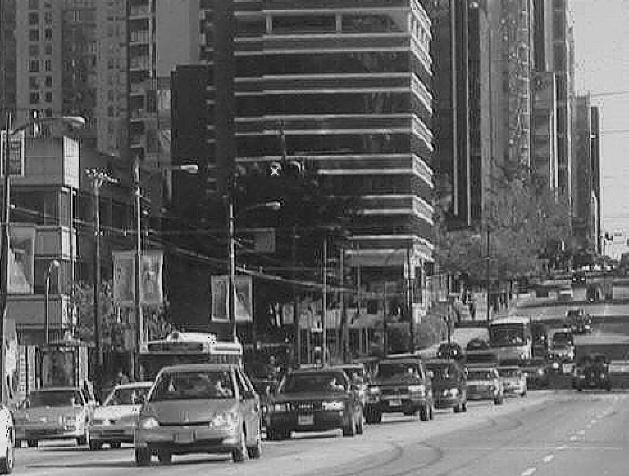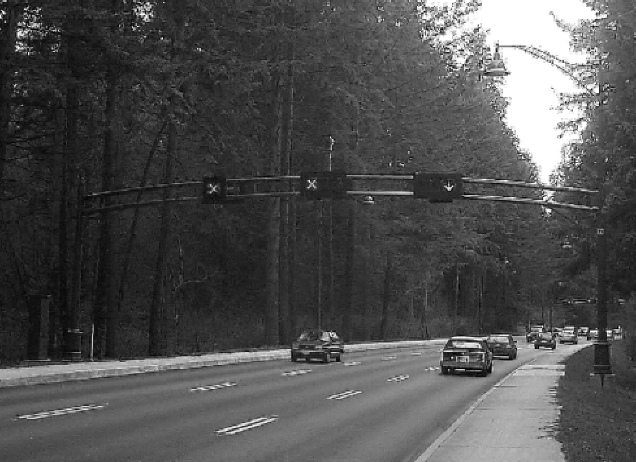

 |

|
ADMINISTRATIVE REPORT
Date: November 30, 2001
Author/Local: Jim Hall/
604-873-7130
RTS No.: 02268
CC File No. 5761
T&T: January 15, 2002
TO:
Standing Committee on Transportation and Traffic
FROM:
General Manager of Engineering Services
SUBJECT:
Georgia Street Signal Upgrades - Causeway to Nicola Street
RECOMMENDATION
A. THAT the $400,000 cost of the Georgia Street lane-signals and traffic-signal upgrades be funded with $240,000 from Streets Basic Capital Unappropriated Account No. 30000160 - Arterial/Transit Improvements, $45,000 from the 2001 Basic Capital Traffic Signals A3, and $115,000 from Streets Basic Capital account #30003215 - Grandview/Skeena; and
B. THAT a pedestrian/cyclist signal be installed at the Georgia/Nicola intersection at a cost of $75,000 with funding from the 2001 Basic Capital Traffic Signals A3.
COUNCIL POLICY
Council approved funding levels for traffic signal installations as part of the 2000-2002 Streets Capital Plan.
On May 27, 1997, Council approved the Vancouver Transportation Plan which emphasizes the need for improved pedestrian and cycling facilities.
INTRODUCTION
As part of the Lion's Gate Bridge and Stanley Park Causeway project, bike lanes are being built on Georgia Street between Chilco and Nicola Streets. This provides an opportunity to upgrade the existing traffic signals and overhead lane controls to bring them up to current standards. Signage for the Higher Occupancy Vehicle (HOV) lane will also be upgraded to ensure consistency and to reduce the number of signs. A new pedestrian - cyclist signal is warranted at the Georgia-Nicola intersection.
TRAFFIC AND LANE SIGNALS
The Georgia Street public consultation process has resulted in retention of the reversible lanes on Georgia Street. The widening of Georgia Street to accommodate the bike lanes requires that the existing trolley poles on the south side of Georgia Street be moved and replaced. These works affect the traffic signals and overhead lane controls, providing a cost-effective opportunity to upgrade these signals. Two existing traffic signals, Denman/Georgia and Cardero/Georgia, require rebuilds as part of this work due to their age, condition and the widening.
The existing overhead lane controls comprise a series of small, single overhead lane signals. These facilities are aged and due for replacement. Staff have noted that drivers are not always aware of the overhead lane controls especially when changes to the hours of operation occur. Upgraded overhead signals to Ministry of Transportation and Highways standards will ensure the signals are more noticeable and provide an improved level of safety for road users. This would provide sets of three larger overhead lane controls that are consistent with those now installed on the Causeway and Lions Gate Bridge. Attachment "A" provides examples of the existing overhead signals on Georgia Street and the new overheads on the Causeway.
Design changes are proposed to Pender Street to remove the need for any reversible lane signals on Pender Street, which also allows for a short queue-jumper to assist transit vehicles.
The High Occupancy Vehicle (HOV) lane signage will also be upgraded as these are nearing the time for replacement and have been added to by tabs rather than redoing the overhead signage. This will provide a set of consistent HOV lane signs on the corridor.
PEDESTRIAN-CYCLIST SIGNAL
The proposed bike lanes on Georgia Street extend from the Stanley Park "S" curve to connect to the Pender Street cycling facilities. A joint pedestrian/cyclist light at the Georgia/Nicola intersection serves to provide the eastbound cycling connection to Pender Street. Cyclists heading east in the bike lane would cross Nicola Street and enter a bike box on the Nicola Street approach to the intersection. A bike box provides priority for cyclists by allowing them to stop at the front of the queue of cars on Nicola Street. In this way, they can better position themselves to proceed across Georgia Street to access the Pender Street bike facility. The bike box has been successfully implemented in Europe and Australia. Referred to as an Advanced Stop Line (ASL) for cyclists, it is designed to help cyclists through signalized intersections by enabling them to proceed ahead of motor vehicles and clear the intersection first. This makes them more visible to motorists and can reduce the risk of conflict.
Concerns have also been forwarded to staff by area workers regarding the pedestrian safety of the crosswalk at the Georgia/Nicola intersection. A marked and signed pedestrian crosswalk is located at this intersection to assist pedestrians crossing Georgia Street. A pedestrian signal at this intersection is warranted.
CONSULTATION
The pedestrian-cyclist signal at the Georgia-Nicola intersection has been reviewed and endorsed by the Bicycle Advisory Committee.
The West End Residents' Association has requested that a "no left turn" sign for traffic from Nicola Street northbound to Georgia Street westbound be installed. This is to prevent the potential attraction of shortcutting commuters to this intersection. It is recommended that this request be forwarded to the Downtown Transportation Plan Team, to resolve in discussions with other nearby residents and a review of traffic conditions in the area. The Association has also requested that the signal give immediate response to a pedestrian request for crossing the street during non-peak hour periods. The response to pushing the button by either a cyclist or pedestrian will be minimized to the extent possible.
FINANCIAL IMPLICATIONS
The cost of the Georgia Street signal upgrades is estimated at $400,000. Funding of $240,000 can be provided from an existing Streets Capital Unappropriated account set aside for arterial and transit improvements, $45,000 from the 2001 Basic Capital Traffic Signals A3, and $115,000 from funds approved by Council for the Grandview/Skeena left-turn bay project. There are funds available from the Grandview/Skeena project due to recent cost sharing in the project by other parties.
The total cost of the Nicola-Georgia pedestrian-cyclist signal is estimated at $75,000. Funding is available from the 2001 Basic Capital Traffic Signals A3. As this work is located on the major road network, it is expected that TransLink will fund 50% of the costs.
CONCLUSION
The reconstruction works on Georgia Street for the bike lanes provide an opportunity to upgrade the existing overhead lane controls to improve visibility and to bring them up to Provincial Standards consistent with the lane controls on the Causeway and across the Lions Gate bridge. Two signals will also be upgraded due to the changes made for widening Georgia Street.
The pedestrian-cyclist signal at the Georgia/Nicola intersection will serve the cycling connection from the eastbound Georgia Street bike lanes to the Pender Street cycling facility. A pedestrian signal at this intersection is warranted.
* * * * *
Attachment "A". Comparison Between Reversible Lane Controls on Georgia Street and Causeway

Georgia Street Reversible Lane Signals

Causeway Reversible Lane Controls
![[City Homepage]](/graphics/footnava.gif)
|
![[Get In Touch]](/graphics/footnavb.gif)
|

|

|

|
(c) 1998 City of Vancouver